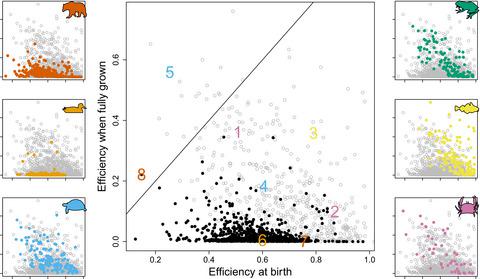当前位置:
X-MOL 学术
›
Ecol. Lett.
›
论文详情
Our official English website, www.x-mol.net, welcomes your
feedback! (Note: you will need to create a separate account there.)
Production efficiency differences between poikilotherms and homeotherms have little to do with metabolic rate
Ecology Letters ( IF 7.6 ) Pub Date : 2020-11-09 , DOI: 10.1111/ele.13633 Jaap van der Meer 1, 2, 3
Ecology Letters ( IF 7.6 ) Pub Date : 2020-11-09 , DOI: 10.1111/ele.13633 Jaap van der Meer 1, 2, 3
Affiliation

|
The idea that homeothermic populations have a much lower production efficiency than poikilothermic populations, because warm‐blooded individuals exhibit a higher metabolic rate per gram of body weight, is widespread. Using Dynamic Energy Budget (DEB) theory, in combination with a modelling exercise based on empirical data for over 1000 different species, I show that this idea is wrong. Production efficiency of homeothermic individuals can be as high or even higher than that of poikilotherms. Differences observed are merely the result of different energy allocation and life‐history strategies. Birds, for example have evolved to invest a large proportion of the assimilated energy in somatic growth and maintenance and to mature at a relatively large size. Therefore, their production efficiency as an adult is low. This low reproduction efficiency combined with a low mortality rate causes the low production efficiency of bird (and other homeothermic) populations.
中文翻译:

变温动物和恒温动物之间的生产效率差异与代谢率关系不大
人们普遍认为,恒温人群的生产效率比变温人群低得多,因为温血个体每克体重的代谢率较高。使用动态能量预算 (DEB) 理论,结合基于 1000 多个不同物种的经验数据的建模练习,我证明了这个想法是错误的。恒温个体的生产效率可以与变温动物一样高甚至更高。观察到的差异仅仅是不同的能量分配和生活史策略的结果。例如,鸟类已经进化到将大部分同化能量投入到体细胞的生长和维持上,并以相对较大的体型成熟。因此,他们成年后的生产效率较低。这种低繁殖效率加上低死亡率导致鸟类(和其他恒温动物)种群的生产效率低下。
更新日期:2021-01-11
中文翻译:

变温动物和恒温动物之间的生产效率差异与代谢率关系不大
人们普遍认为,恒温人群的生产效率比变温人群低得多,因为温血个体每克体重的代谢率较高。使用动态能量预算 (DEB) 理论,结合基于 1000 多个不同物种的经验数据的建模练习,我证明了这个想法是错误的。恒温个体的生产效率可以与变温动物一样高甚至更高。观察到的差异仅仅是不同的能量分配和生活史策略的结果。例如,鸟类已经进化到将大部分同化能量投入到体细胞的生长和维持上,并以相对较大的体型成熟。因此,他们成年后的生产效率较低。这种低繁殖效率加上低死亡率导致鸟类(和其他恒温动物)种群的生产效率低下。











































 京公网安备 11010802027423号
京公网安备 11010802027423号